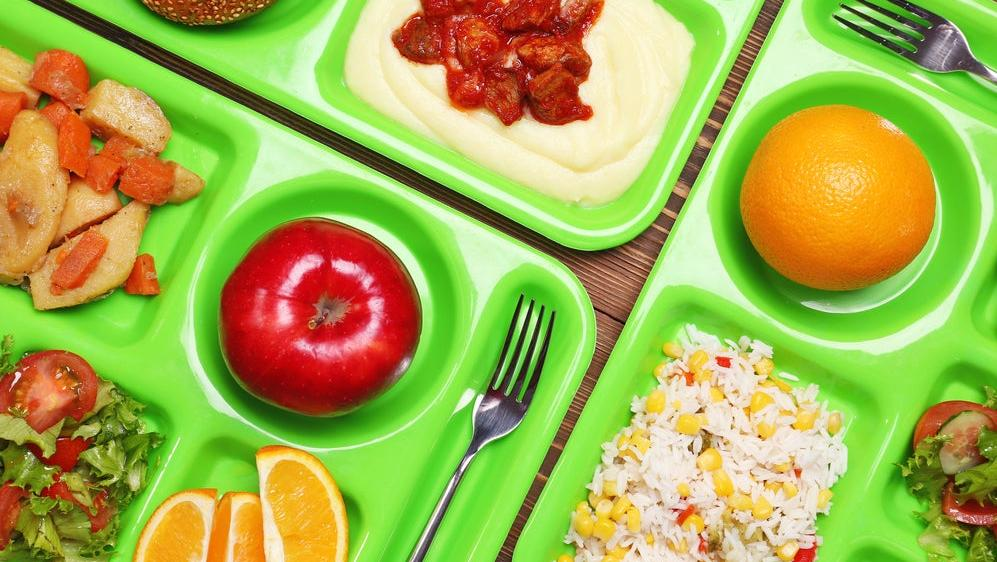Are School Lunches Really Better Than They Used To Be?
The many challenges of feeding the future of America.
A defining moment of my high school dining experience was the taco bowl. A giant heaping of ground meat, lettuce, tomato, onions, and sour cream topped with generous amounts of shredded cheese, all encased in a flower-shaped taco shell bigger than my hand. Taco bowls arrived at my school cafeteria several times a month, almost always doled out by grim-faced lunch ladies all clad in white.
When I asked my partner, another millennial and public school graduate, what he remembered most about his high school lunches, he didn't hesitate.
"Cheese," he replied immediately. "Lots of cheese."
While he and I were recipients of highly processed and salty foods, children in public schools today are offered other options. At my kids' school, they get unlimited amounts of fruits and vegetables with every meal, a perk I never had. But are school lunches really better now than they were 20 years ago? Or is it simply a reorganization of how choices are presented to kids?
Feeding children in schools
Harry S. Truman, 33rd US president, is known for many pivotal decisions, but the signing of the National School Lunch Act that created the National School Lunch Program (NSLP) in 1946 is a less celebrated one. His reasons were twofold: to provide a hot meal for every child who couldn't afford one, but also to absorb farm surpluses. Schools that participated in the program received federal subsidies in exchange for following nutrition guidelines set forth by the U.S. government.
Decades later, under the Obama administration, Congress passed the Healthy Hunger-Free Kids Act of 2010. Also known as the "child nutrition reauthorization bill," the HHFKA program provided additional funding to schools across the country as a way to increase access to healthy foods for children.
Feeding kids in numbers
In fiscal year 2019, the last "normal" school year, there were 29.6 million meals served to children, 21.8 million of which were free or at reduced cost. The cost of these meals are determined by the schools themselves, who in turn receive a reimbursement from the U.S. Department of Agriculture. Meal prices will vary depending on region, but average rates tend to be around $2-3 for lunch and $1-2 for breakfast.
During the pandemic, when many schools were closed, supplemental programs were created to offset the lack of meals being served in schools. This included the Seamless Summer Option (SSO) and the Pandemic Electronic Benefit Transfer (P-EBT), at a cost of $28.4 billion and $28.3 billion in fiscal year 2021, respectively.
School lunches in other countries
Despite these efforts to supplement the existing programs, there's still lots of room for improvement. Perhaps we can stand to learn a thing or two from how other countries feed their children.
France is a country known for their high-quality school lunches. Like dining in a restaurant, French school children are given a starter (example: beet salad), a warm entrée (pasta, maybe), and a dessert (perhaps ice cream). Unlike American children, French children are given at least 30 minutes to eat every day, sometimes up to two hours. Why? Because the French believe in well-prepared meals and savoring their food, and they give children the autonomy to decide how much time they need to eat.
Japan is another country well-known for its school lunch programs. The Japanese follow a model called shokuiku, meaning "food education," which emphasizes autonomy and instruction. In this system, children eat and learn at the same time, with lessons that pertain to the exact meal they're eating (a menu that has been designed by nutritionists for this purpose). Japanese children are also expected to clean up after themselves.
The challenges of feeding children today
"Certainly, what a healthful school meal looks like varies tremendously, depending on geography and one's definition of health," wrote Kim Severson in The New York Times. "Large, urban schools face different challenges from small rural ones." One of the challenges of feeding children these days is the availability of foods by region. Then there are critics who say that school lunches just aren't tasty.
In America, meal periods are generally 25-30 minutes, but can be as short as 15 minutes. This leaves little time for children to enjoy their foods, especially when you count the time spent in line waiting for it. (I know from experience how excruciatingly long the lunch line can be). The Centers for Disease Control and Prevention recommends at least 20 minutes of seat time for every child, which doesn't include time spent waiting in line, washing one's hands, or restroom breaks. Despite the recommendation, about half of the nation's school districts do not make this a requirement.
Have school lunches really improved all that much?
Some say that school lunches in America are, for the most part, better than they used to be. But when I looked at school lunch menus from several school districts in my area (including my children's school), I discovered the same familiar monochromatic configurations of brown, yellow, and beige, made more challenging by the bureaucracy that comes with the allocation of costs and strict nutritional guidelines.
Perhaps by the time my children have children of their own, school lunches in America will become more aligned with the French way of doing things, or the Japanese method. In the meantime, there will be pizza, chicken nuggets, beans, potatoes, and pasta...and yes, taco bowls, but with a side of fresh fruit to go along with them.
